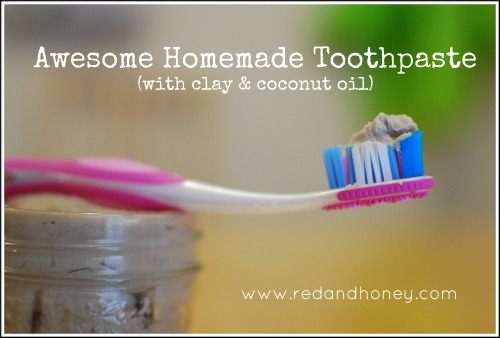
I’ve seen many homemade toothpaste recipes floating around internet-land for a few years now.
Most recipes are a baking soda mixture, and while I have serious respect for the power of baking soda (it’s an awesome tub cleaner!), the thought of it in my mouth makes me scrunch up my nose and keep on buying those danged expensive little tubes of all-natural toothpaste from the local health store.
Then, I saw this post on Keeper of the Home where Stephanie makes homemade clay toothpaste. She essentially made her own Redmond Earthpaste – how awesome is that?! I recently got a tube of Earthpaste in the mail from the ebook bundle freebies, and I am loving it.
Being on a every-penny-pinched kind of budget though, I’m not loving the price. I mean, if you’re going to buy an all-natural flouride-free toothpaste (definitely a good idea if you aren’t going to make your own) then Earthpaste is definitely one of the best out there, and fairly priced too.
However, since I needed a more frugal option I opted to attempt to make my own concoction. (I love how the little things can really add up to big savings in the long run!). Woot woot! It turned out fabulously, and I am sharing the recipe below.
How Frugal Is It Compared to Store-Bought?
Redmond Clay – bought a jar for around $10, used 1/4 cup for a cost of $1.30 (found at a local natural health store)
Organic Virgin Coconut Oil – bought a jar for around $10, used 2 T for a cost of 68 cents.
Xylitol – approximately 25 cents worth (bought at the Bulk Barn, and I don’t honestly remember how much it cost, so this is a guesstimate!)
Peppermint Extract – a small container for around $3, used 2 teaspoons for a cost of 70 cents.
Redmond Real Salt – I only used 1/2 teaspoon of salt, so I didn’t bother calculating it.
Water – free. (OK, so technically I used the water from our Berkey, so maybe it cost a penny or two towards the cost of a new filter in 2-3 years…)
TOTAL COST: $2.93 for 130 ml (I used a little 125ml mason jam jar, and there was a little extra, so we all brushed our teeth and then squished the rest in as best we could!)
Cost of Redmond Earthpaste where I could buy it online (with free shipping here): $6.59 for 113 g.
The bottom line? My homemade version is approximately 60% cheaper!
When you calculate the annual costs for a family of five like ours, brushing our teeth twice a day, you will save approximately $326.50/year!
That’s no small chunk of change, and most definitely worth it in my opinion… especially when you consider the fact that this toothpaste feels and tastes just as good as the regular stuff. I actually find that it makes my teeth and mouth feel smoother and cleaner than ever. I’m guessing that if I were to try and suck it up and use a homemade baking soda kind, I’d likely give up on it eventually.
Why Not Conventional Toothpaste?
The toothpaste brands typically found on store shelves are full of harmful ingredients that you really don’t want to be ingesting; such as sodium lauryl sulfates (SLS), artificial flavours and colourings, parabens, fluoride, glycerin, and more. The EWG (a non-profit information agency) says
“Many people believe that companies are required to test personal care products for safety before they’re sold. It’s not true. While many companies make perfectly safe products, other personal care products that you use every day might be laden with carcinogens or miscellaneous chemicals that no one has ever studied the health effects of.”
SLS’s are one of the worst chemicals found in body care products. It is a chemical foaming agent that has been associated with a host of health issues. Many thousands of scientific medical studies have proven the toxicity of sodium laurel sulfate, and I for one do not want it anywhere near my family if I can help it. It’s in so many conventional body care products these days!
The safety of using fluoride has also come into serious doubt recently. This article has some excellent info. Interestingly, more and more people are starting to recognize the dangers of fluoride, such as the city of Calgary (an hour from Tiny Town!) which has voted to ban all fluoride in the public water supply.
Another ingredient that is in virtually all store-bought toothpaste (even the natural brands!) that I wanted to avoid is glycerin. This relatively harmless ingredient actually wreaks a lot of havoc by leaving a coating on your teeth, which does not allow them to remineralize on their own, leading to more cavities. The book Cure Tooth Decay by Ramiel Nagel is the one most commonly cited by other writers on this subject, though I haven’t personally read it yet myself.
The Amazing Power of Clay
The clay is a fabulous starring ingredient in this toothpaste as it is smooth and mostly tasteless on its own. It has incredible medicinal properties as well so that if you accidentally swallow some it’s totally safe (and even potentially beneficial).
There are a number of scientific studies published that show the power of clay to draw out toxins from the body. It is often used for stomach/bowel upsets, and it has even been proven to have a powerful role in the adsorption of radiation. Toxins are attracted to the clay like a magnet and carried out of the body. This process is called adsorption (spelled with a “d”). Clay has been used therapeutically for thousands of years, and is starting to see a resurgence in popularity once again.
Why I Didn’t Use Essential Oils or Baking Soda
I decided to not use any essential oils because I have concerns about the safety of ingesting them, especially on a daily long-term basis. You may think it doesn’t matter since we spit it out, but since my four-year-old son loves to declare that “Toothpaste is my favourite food, Mommy!” whenever he brushes his teeth, I decided that spitting the toothpaste out was not a safe bet.
I also have concerns about having things in my mouth that I’m not comfortable ingesting due to the absorbing nature of the mucous pathways of our bodies (think eye, nose, mouth, etc).
Some claim that ingesting small amounts of certain higher-quality oils is safe, but even that is not on a daily long-term basis. Either way, essential oils are powerful things, and they can make a person quite sick if used incorrectly.
So, I needed something else for the minty flavour and preferably something else with antibacterial properties. I decided to use peppermint extract and xylitol for taste (minty and sweet), and coconut oil for its antibacterial properties.
You could easily sub in stevia for sweetener if you’d like, but I didn’t for a couple of reasons: 1) I didn’t have any on hand 2) The first brand I’ve tried had a yucky aftertaste and I haven’t wanted to drop the money on trying more to find one I like, and 3) there are many studies citing the benefits of xylitol on reducing or healing cavities.
I also decided to avoid baking soda, which is the basis of most homemade toothpaste recipes, for a couple of reasons. First, because the taste is just gross to me. I’ve also heard conflicting reports about using baking soda on your teeth. Many say that it is too abrasive, and too harsh for daily use on teeth and gums.
The Recipe
1/4 cup Redmond clay
1/3 cup boiling water
2 tablespoons coconut oil
3 teaspoons xylitol
2 teaspoons peppermint extract
1/4 teaspoon salt
Mix clay and salt in a bowl, then add boiling water. Mix well with a hand mixer, then add the rest of the ingredients. Mix all together well, store in an airtight container, and throw out your colgate.
(Edited to add: I find mine fairly stiff in texture, so feel free to add extra hot water (a tablespoon at a time) to get the consistency you want before putting it in the container).
I have mine in a small mason jar for now, and I plan to keep a little butter knife or spoon with it to use to apply the toothpaste to the brush. Dipping it in won’t work because of the potential contamination of bacteria, and the texture is a bit too thick for that to work well anyway.
I love this toothpaste, my family loves it, and there’s no way I’m ever going back!


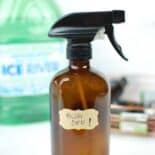

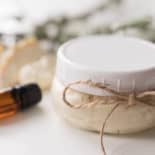



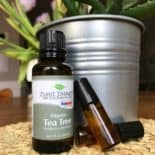
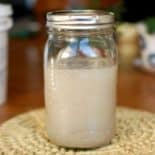

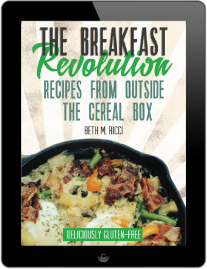

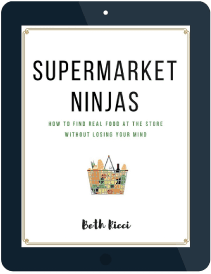
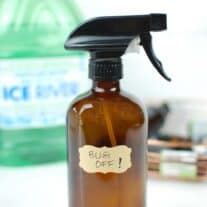

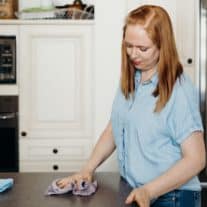




Brenda McCament
I have made and used this toothpaste with success on my second try. I am thinking about dropping the baking soda and rethinking the essential oil. Putting it in a squeezable tube really helps unclutter my routine. I do use the trace minerals because I have them on hand. Good luck and have fun. Here is the link: http://wellnessmama.com/8780/squeezable-homemade-toothpaste/
Francine
Hi! Thanks so much for this post/recipe. So far it is the best tasting toothpaste I’ve made so far. I just made my first batch of this particular recipe. My hubbie and I have made other recipes and have added essential oils to them, particularly peppermint, and it is really bitter. Now, the xylitol helps, but I can still taste bitterness in there. So, my question is: Is the peppermint oil supposed to be food grade? Is this why it is bitter tasting? Ir is this the way it is supposed to taste? I use NOW essential oils 100% pure peppermint, if that helps you.
meggs
i left the salt out and there is no bitterness. i was wondering though about the clay. i read that it was not supposed to come in contact with metal. so i didnt use a mixer or a spoon to scoop it out with. i was thinking of a goo tube. they sell them on amazon. have you heard about the metal thing? thank you
Francine
I have not heard of that.
Rebecca
You are not supposed to use metal with clay, that is right. Clay attracts heavy metals and it is important to use plastic or wood so as to not absorb any heavy metals. Thankfully in toothpaste you don’t swallow it (except kids maybe?) and since you spit this out, the metals will still be bound to the clay. But when I drink clay (I actually mainly use Diatomaceous Earth and Zeolite, and then occasional french green clay, I hate the consistency of the bentonite redmond clay in water to swallow), I use a plastic spoon to stir (the 1 TB size measuring spoon).
mommy2baby
It’s probably bitter because you used essential oil. The original post uses extract. An extract is different from an essential oil and it will change the concentration of the peppermint taste.
Francine
Thanks for letting me know. That makes sense.
Lisa
Hello, much research today on homemade things like this. Slowly switching my family of 6 over to more healthy options. Found a similar recipe that doesn’t use water (also used baking soda), can this be done without water? Concerned with potential mold growth & our water fluoridated and gross. We purchase bottled or filter. Maybe try clay at some point but, strict finances here at the moment.. Thank you 🙂
Beth
Hmmm, the water is pretty necessary in this recipe for the dry clay to rehydrate. What if you used distilled water? Or filtered? What kind of filter do you use?
Lisa
Thank you Beth,
I actually made some cpl days ago with just baking soda, coconut oil, stevia (had never used b4), peppermint & orange extract. It seems to work ok but, not perfected yet. Was real liquid due to the weather I think, so refrigerated. And I can deal with the taste but hesitant to let finicky family taste buds try. LOL! Not sure about ratios for extracts but did about tbsp of CO & baking soda & tsp of stevia, maybe tsp each…(was hard to pour w/o spilling) Lisa 🙂
Lisa
*Oops! supposed to say tsp each of extracts appx..
Andrea B
Try KAL pure stevia–I used to hate stevia until I tried this one. KAL and Nunaturals are the two brands people like best. I’m on an email list with about 8,000 people and those two are the ones everyone recommends.
Some peopel grow their own and dry it/grind it, but that has more of the yucky taste, I think–prob depends on the soil, though.
Try KAL. You can order it online. (I was going to skip the xylitol since I read an article on how horrible it is health-wise, highly processed, made from GMO corn, etc., but found one that claims it has no GMO’s and decided to try it.)
Deborah
Andrea B – which brand of xylitol did you find and use?
Meg
I must be a messy brusher!
I have recently tried a different coconut oil recipe but both the brush and handle of the toothbrush would get very greasy. How do you clean yours afterwards? I was worried that the oil on the brush was getting rancid because after just a few days of starting with it, it began smelling and tasting a little fishy and freaked me out!!!
Any thoughts or suggestions?
Beth
Whoops, sorry Meg – I missed responding to this! I don’t seem to have that issue… but I would think you could just boil it for a minute with a little vinegar. Coconut oil is very stable, so it probably wasn’t that… maybe it was the bacteria from your mouth left on the brush? Regardless, boiling it for a minute with vinegar should do the trick. And just make sure the toothpaste is all off when you brush each time – I use my finger to swish the bristles sometimes under running water.
Lisa
Ooh…! I just started and noticed my brush oily too but, I have battery operated one, hope I don’t have problem.
Coconutoilgood
If you want to avoid the essential oil you can add cinnamon, it tastes fabulous!
http://Www.coconutoilgood.com
Beth
That’s a great idea! I’ll have to try that 🙂
Colleen
Just had a question about the consistency of the paste. I made a toothpaste that was similar, but the coconut oil made it harden when it cooled down. Anyone experience that with this recipe?
Coconutoilgood
The coconut oil will go hard in cooler temperatures so the paste becomes crumbly. I take a piece and rub it against my gums and teeth to get it going before I brush.
http://Www.coconutoilgood.com
Beth
It all depends on the temp of your bathroom (or wherever you store it). It’ll soften as soon as it gets into your mouth and should still work fine. Coconut oil hardens at just under room temp.
Mallory
Hello!! This looks amazing. I was wondering:
1. Is there anything special about Redmonds clay or can I use Bentonite clay instead?
2. What is Redmonds Real Salt? Could I use sea salt as an alternative?
Can’t wait to make it!
Beth
Hi Mallory! Sorry I didn’t respond to this until now! You can certainly use another bentonite clay, as far as I know. I only have experience using Redmond’s so far, but if I found a cheaper alternative I might try it… as long as I felt ok about the quality (since small bits are being ingested, especially by my kiddos!). Redmond’s real salt is sea salt without the bleaching and processing. “Sea salt” is not a regulated term at all, so just be sure to use a high-quality salt from a brand you trust. Your salt should be flecked with different colours (not just white), and if they claim that it hasn’t been highly processed by heat, that’s also a good thing. Ultimately you could use any salt, but real sea salt is a whole food, and it’s all we have in our house 🙂
Hope that helps! Thanks for commenting!
Donna
Just wanted to add xylitol is likely toxic for your kids too, since they are smaller like dogs. I have also read a lot of controversy about whether it really is good for the enamel or not. Google Colorful Canary. She is a blogger that did a lot of research on this, and avoids it in her homemade paste. Adds Cell Salts with natural calcium fluoride instead. Also, if you use extracts instead of essential oils, make sure they don’t contain glycerin, or you might as well buy store brand paste. Not sure if the alcohol is good for your teeth either. I would stick with essential oil in small gentle amounts. You can find food grade ones in yummy flavors your kids will love. Happy brushing!
Rain Grant
I was going to mention the xylitol. Everyone says how “clean” it is. Let me remind you that the FDA also said fluoride was good for our teeth too. So no I dont think xylitol is “clean”.
Joven Agno
Honestly, this is my first time that I heard about homemade toothpaste. I am always buying a natural toothpaste that is fluoride free. I better try to make a toothpaste like this with my wife.
Beth
Flouride free is a great first step! Unfortunately, many commercial brands of toothpaste (even the “natural” ones are still filled with things like sodium lauryl sulfates, etc. Not things you want in your mouth!!). I hope you get a chance to make this recipe and enjoy it!
Erin
I’ve been making my own toothpaste for about a year now (coconut oil and baking soda) and I LOVED it, until I went to the dentist last week. My gums are a bit worn down and though there are other factors that could account for it (not being to the dentist in a while, pregnancy hormones, etc.) the hygienist suspected the baking soda. She sad it’s great for a rinse but maybe not for everyday brushing. So how timely is this post! I am super excited to try it out.
Beth
Whoa, I apparently forgot to respond to your comment here months ago. Sorry! Now that it’s May – I’d love to hear if you ended up trying this recipe, and what you thought! 🙂
Erin Long
I LOVE it! I’m about to whip up my third batch. This time I think I’m going to wait a bit for the clay to cool down before adding the coconut oil. Hopefully it won’t get clumy that way. I’ve had to use conventional toothpaste the last few days because I haven’t had time to make any and my mouth does not feel as clean, especially when I wake up. Thanks for sharing this!
Krissa
I’m definitely going to try this! I have everything except the xylitol. I’ve made the baking soda kind before and couldn’t really get into it. I probably will use my doTERRA peppermint essential oil though because it’s safe to use internally. 🙂
Beth
Hi Krissa! Did you end up making the toothpaste? I’d love to hear how it tastes with the essential oil. I find it difficult to get it tasting minty enough with just the extract.
Melinda--Marshmallow Mudpie
Sounds fantastic! We buy fluoride free toothpaste, and it is so expensive! I’d love to start making our own. May I ask why kind of clay you used?
Beth
Sorry, I forgot to specify in the post (I edited it to add it in). I used Redmond clay.
Marissa
Hee Hee, yup, I’ve been making mine out of eggshells. http://becomingkindred.com/blog/2012/11/8/homemade-toothpaste-using-eggshells-or-calcium I know it sounds much less appealing than yours but I and everyone that I have convinced to try it have been very please and say they are never going back. Plus the shells are free :). The coconut oil is an AMAZING tooth whitener. I also went back and forth on using baking soda but decided to use a small amount of it because it is actually much lower on the abrasive scale than a lot of tooth pastes are.
Either way, throwing out the colgate is a good idea!:)
Beth
If I had a source of good eggs I probably would have tried your recipe too. It looks great! I am excited to see if the coconut oil whitens for me! 🙂
Mary Cleveland
Thanks for this post!
I jut found out my nursing babe is sensitive to mint, so had to discontinue use of our mint toothpaste. I made one with coconut oil, baking soda and xylitol tonight, but blech!! I almost gagged from te baking soda taste.
I have clay and will try it tomorrow!
Beth
Oh how interesting! How did you figure out the mint thing??
Hope you like this recipe! Let me know how it turns out!
Catherine
This sounds great and I think I will probably try it but I found it lacking in any ingredient for gum health. I would like to suggest adding some propolis for this purpose. You would need to either use a tincture or thoroughly mix the propolis with the oil/clay before adding water as it does NOT mix well with water. This, of course, is just a suggestion but propolis is excellent for gum health and you will often find it in toothpaste and mouthwash ingredient lists. 100% natural, a product produced by honeybees.
Beth
Thanks for the suggestion, Cathering. The propolis sounds interesting, I’ll look into it more. I
Catherine
It is a wonderfully heathful product made by honeybees. They collect resins from trees, mainly evergreen, mix it with their wax and you have propolis! You can make a tincture using high grade alcohol (everclear vodka works very well) to use in throat sprays and many other healthful concoctions. Green propolis, one of the healthiest types, can be purchased on Amazon. To get an idea of the many uses of propolis, check out BeePharm products as well as those sold by Mickelberry Gardens. I love the throat spray from Mickelberry and am hoping to make my own version in the near future! There are some extremely beneficial products derived from honeybees … if you don’t have them, you should think about getting a hive in the future … there is NOTHING like being able to eat honey from your own hive .. delicious!!!
Laura
Catherine, could you tell me what form might work best for adding to a toothpaste? Would tablets/capsules mix any better than a liquid would?
Jessie
I’m curious what kind of clay you used. I’ve never used ANY kind besides children’s modeling clay, and I’m pretty sure that’s not what you used. 🙂
Beth
Whoops! Sorry, I forgot to specify. I’ve edited my post now. I used Redmond clay.
Carissa
I am so excited that I found your post! I looked for so long to find a homemade toothpaste recipe but I was also skeptical about the baking soda and essential oils, and they all had one or the other or both. Eventually I just gave up and bought Earthpaste for my son to use while we use a different brand due to how much it would cost if we all used it. After all, he is only 2 so he has no idea to spit it out and there is no way I am going to let him swallow something that isn’t safe, and I feel so good about him using Earthpaste because of what you mentioned above about the clay! I am going to be trying this recipe soon!!
Beth
Hurray! So glad it will be helpful to you… I hope you like it!
Valerie
This is so great! Definitely going to be trying this recipe. I’m all about the homemade stuff these days, and I haven’t found any recipes without baking soda either. I hate baking soda toothpaste! Just for the record though, if essential oils are 100% pure and unadulterated, they can be ingested. I would never ingest any essential oil unless it was Young Living Essential Oils. Other companies either synthetically extract their oils, or cut them with who knows what to make them less expensive. Young Living’s oils are steam distilled (or cold pressed if they are citrus oils) and have absolutely NO additives. Their oils are 100% pure. And YL peppermint oil is definitely safe, so I’ll be using oil in my toothpaste! YUM! Thanks again!
ps…found you on pinterest 🙂
Beth
I’ve heard that Young Living oils are definitely among the best. Unfortunately I don’t have any and I can’t afford them. I would also still question whether a person should be ingesting them on a long-term daily basis. To each their own, though! 🙂 Thanks for your comment!
Dea
Love the idea of using clay– fun! (clay AND eggshells ??) ;))
But, I’ve got to reply to Valeri, as someone who daily works with pure essential oils: there are some oils which should simply NOT be ingested! It doesn’t matter how pure, some chemicals were not created for internal use. Eucalyptus is a great example. It’s so beneficial for external use, but proven as toxic if ingested. These are active compounds which DO impact our bodies on a cellular level. Yes, they’r beneficial, but they also should be used with caution and knowledge.
Katie @Nourishing Simplicity
So funny, I make mine almost the same. I have a post scheduled with my own version this month. I just couldn’t give up using coconut oil in my toothpaste once I switched to bentonite clay! 🙂
Beth
Awesome! I think it’s really a winning combo… hopefully more and more people will ditch the colgate and use this kind of awesome recipe! 🙂
Erin@TheHumbledHomemaker
This recipe looks GREAT, Beth! I’m so glad you did the cost breakdown. I got 3 tubes of Earthpaste in the bundle sales, and I still have two tubes (cause hubby won’t touch it!), but this makes me think I ought to try making my own.
Random, but have you ever hear of soaperschoice.com? I get my coconut oi there. I can get a 7 lb. bottle of extra virgin organic for $33.
Beth
Thanks Erin! 🙂 I haven’t heard of soaperschoice, and I took a quick look, but it looks like they don’t ship to Canada 🙁 So many companies won’t ship here, it’s frustrating! Glad you can get a great deal though – that makes this toothpaste even cheaper for you! 🙂